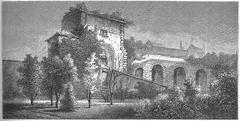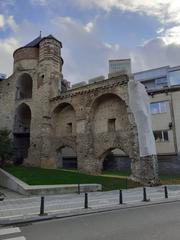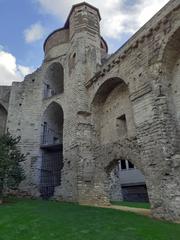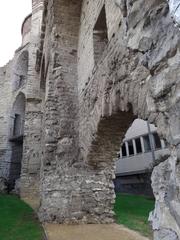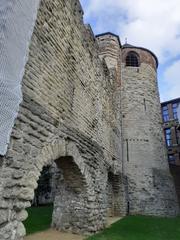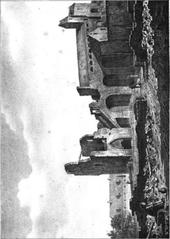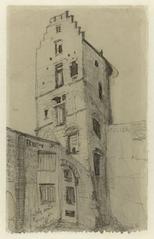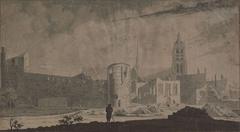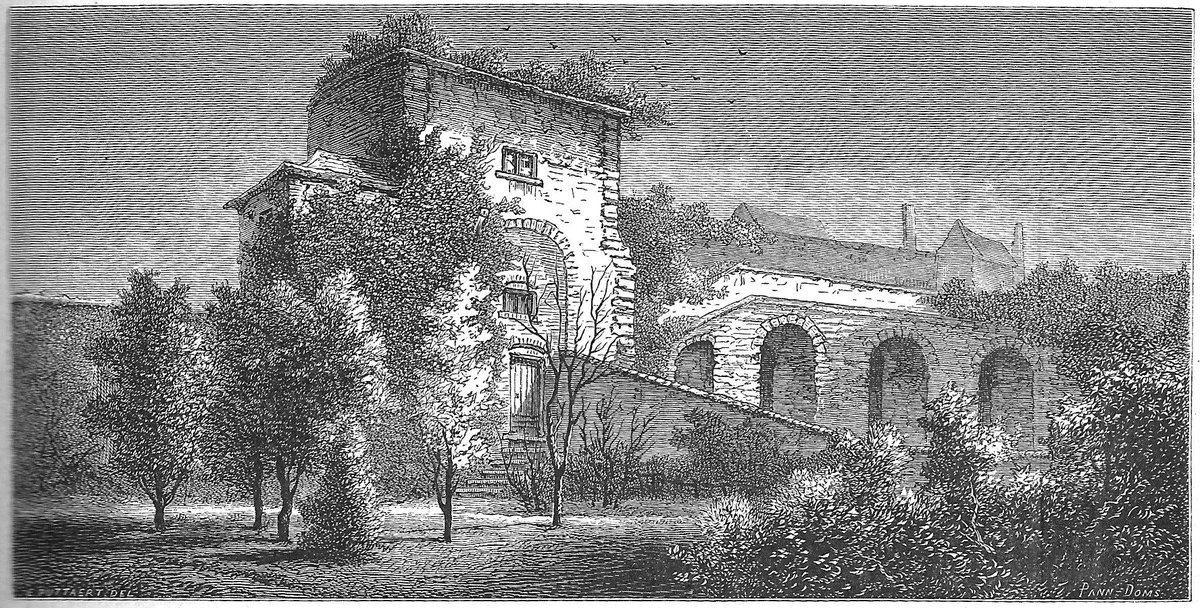
First Fortifications of Brussels: Visiting Hours, Tickets, and Historical Sites Guide
Date: 14/06/2025
Introduction: Brussels’ Medieval Walls and Their Enduring Legacy
Brussels, the dynamic capital of Belgium, conceals within its bustling streets a fascinating medieval heritage, most notably the first city fortifications built in the early 13th century. These initial defensive walls, known as the première enceinte (French) or eerste stadsomwalling (Dutch), were crucial in protecting the growing city, managing trade, and shaping urban development. Today, traces like the Black Tower and Anneessens Tower stand as poignant reminders of this rich past, embedded within the city’s historic center, the Pentagon (bimcc.org; Audiala; BrusselsLife).
This detailed guide provides everything you need to explore the first fortifications of Brussels, including historical context, visiting hours, ticketing, accessibility, practical travel tips, and recommendations for nearby attractions. Whether you are a history enthusiast or a casual visitor, this resource will help you delve into the medieval roots of Brussels.
Table of Contents
Historical Background
Origins and Construction
Brussels’ first fortifications were constructed in the early 1200s, during a period of rapid urban growth and increasing regional threats. The walls encircled approximately 80 hectares, forming an oval-shaped enclosure that defined the medieval city’s boundaries. Built mainly from local stone, the structure included about 50 towers and seven gates, which controlled access and facilitated customs collection. This system not only protected the city but also helped regulate commerce and maintain order (dbpedia.org; BrusselsLife).
Expansion and Adaptation
By the mid-14th century, the city had outgrown its original enclosure. A second, much larger ring of walls was constructed, forming the foundation for modern Brussels’ pentagonal center. The new fortifications featured advanced military concepts, such as taller ramparts, moats, and seven major gates aligned with key trade routes. As military technology advanced, additional bastions and outworks were added, but ultimately, the walls became obsolete with the rise of artillery and new warfare methods (bimcc.org).
Dismantling and Urban Transformation
Following the decline of their military function, the fortifications were gradually dismantled, particularly in the late 18th and 19th centuries. Emperor Joseph II’s decree in 1782 initiated the removal of the walls, which were soon replaced with wide boulevards and promenades. Today, these boulevards form Brussels’ distinctive inner ring road, preserving the historical footprint of the fortifications in the city’s urban plan (bimcc.org).
Surviving Elements and Legacy
Most of the original city walls have disappeared, but key remnants remain, such as the Black Tower near Sainte-Catherine, Anneessens Tower, and the Halle Gate (Porte de Hal). These structures are recognized as protected heritage sites, offering valuable insights into medieval life and defense architecture. The city’s layout, street names, and cultural memory continue to reflect the influence of these early fortifications (dbpedia.org).
Visitor Information
Key Sites: Black Tower, Anneessens Tower, Halle Gate
Black Tower (Tour Noire / Zwarte Toren)
- Location: Near Sainte-Catherine’s Church, central Brussels
- Description: A rare 13th-century cylindrical tower, the Black Tower stands as an evocative piece of medieval Brussels architecture, now surrounded by modern buildings (Audiala).
- Visiting Hours: Exterior accessible at all times; interior access during heritage events
Anneessens Tower (Tour Anneessens)
- Location: Boulevard de l’Empereur 35, 1000 Bruxelles
- Description: A well-preserved defensive tower with original arrow slits, visible from the street (BrusselsLife).
- Visiting Hours: Exterior accessible 24/7
Halle Gate (Porte de Hal)
- Location: Boulevard du Midi / Zuidlaan 150, 1060 Brussels
- Museum Hours: Tuesday–Sunday, 10:00 AM–5:00 PM; closed Mondays
- Tickets: Adults €5; reduced €3; free for children under 12
Visiting Hours and Tickets
- Black Tower and Anneessens Tower: Free to visit exterior; open at all hours as outdoor sites. Interior visits are rare and usually part of special events.
- Halle Gate Museum: Admission charged; guided tours available on weekends and by appointment.
- Brussels City Museum: Offers models and displays on the first walls; open Tuesday–Sunday, 10:00 AM–5:00 PM (Brussels City Museum).
Accessibility and Getting There
- By Metro: Nearest stations include Sainte-Catherine (Black Tower), Parc (Anneessens Tower and Villerstoren), and Porte de Hal (Halle Gate).
- By Bus/Tram: Multiple lines serve the city center and historic sites.
- On Foot: The main fortification sites are within walking distance of Grand Place and Brussels Central Station.
- Accessibility: Most outdoor sites are accessible at street level, though some cobblestone areas may pose challenges for visitors with limited mobility.
Travel Tips and Visitor Experience
- Footwear: Wear comfortable shoes for exploring cobblestoned streets.
- Best Times to Visit: Early mornings and late afternoons offer the best light and fewer crowds.
- Tours: Guided walking tours are available through local operators and during annual Heritage Days, providing deeper historical context (Gemini Gypsy Diaries).
- Photography: The unique mix of medieval and modern architecture makes these sites particularly photogenic.
- Amenities: Cafes and restaurants are plentiful in the Sablon and Sainte-Catherine areas.
FAQs
Q: Are the first fortifications of Brussels open year-round?
A: Yes, the outdoor remains can be visited at any time. Some interior spaces, such as the Halle Gate, have fixed hours.
Q: Is there a ticket fee to visit the medieval walls?
A: Viewing the exterior remnants is free. Admission is required for museums and guided tours.
Q: Are guided tours available?
A: Yes, several organizations offer tours focusing on the city’s medieval history and fortifications.
Q: Are the sites accessible for people with limited mobility?
A: Many sites are accessible at street level, though uneven cobblestones may be challenging.
Q: Can I take photos?
A: Yes, photography is welcome and encouraged.
Additional Points of Interest
- Bruxella 1238: Archaeological site near the Bourse, revealing ruins of a 13th-century Franciscan convent (BrusselsLife).
- Saint-Nicolas Church: One of Brussels’ oldest churches, located near the former fortification line.
- Tour de Villers: Another surviving tower, located at Rue de Villers 29.
- Tour du Pléban and Porte du Treurenberg: Remnants behind the Cathedral of Saint Michael and Saint Gudula, accessible during Heritage Days.
References
- Fortifications of Brussels - DBpedia
- How Brussels Grew - BIMCC
- Black Tower Brussels - Audiala
- Medieval Brussels: Going Back to the Source - BrusselsLife
- Brussels Old Map - Brussels Map 360
- Two Days in Brussels: Ultimate Weekend Itinerary - ImJustAGirl16.co.uk
- Stadsmuur en Villerstoren - Evendo
- Brussels Tourism - Brussels City Museum and Visitor Info
- 1 Day in Brussels - Gemini Gypsy Diaries
- Belgium Travel Tips - Happy to Wander
- 11 Practical Tips Visiting Brussels - Away With Maja
Conclusion
The first fortifications of Brussels are more than just ancient stones—they are living witnesses to the city’s medieval resilience, growth, and evolving identity. The surviving towers and wall fragments, complemented by museums and interpretive centers, invite visitors to explore the city’s origins and understand its transformation into a modern European capital.
To maximize your visit, download the Audiala app for audio guides and walking tours, check for special events during your stay, and consult official tourism resources for the latest information. Exploring these historical remnants provides a unique and immersive journey through time, making the first city walls an essential stop for any Brussels itinerary.
Sources
- Fortifications of Brussels - DBpedia
- How Brussels Grew - BIMCC
- Black Tower Brussels - Audiala
- Medieval Brussels: Going Back to the Source - BrusselsLife
- Brussels Old Map - Brussels Map 360
- Two Days in Brussels: Ultimate Weekend Itinerary - ImJustAGirl16.co.uk
- Stadsmuur en Villerstoren - Evendo
- Brussels Tourism - Brussels City Museum and Visitor Info
- 1 Day in Brussels - Gemini Gypsy Diaries
- Belgium Travel Tips - Happy to Wander
- 11 Practical Tips Visiting Brussels - Away With Maja
